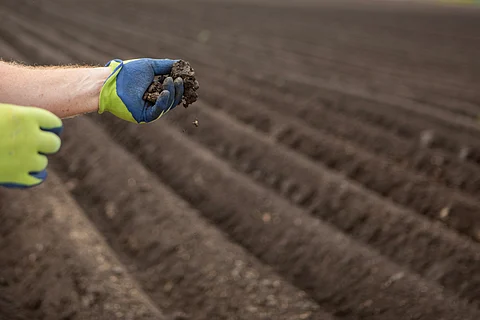

Concentration of research: Just 10 countries, led by China, the US, India, Brazil and Spain, account for 70% of all global soil health research since 1947.
Geographic “blind spots”: Large parts of Africa, south-east Asia, central and South America (excluding Brazil) and the Middle East receive little scientific attention, despite facing severe threats such as deforestation, erosion and climate change.
Climate justice gap: Many neglected regions have low per capita emissions yet suffer high land-use change emissions from deforestation and farmland expansion, with limited capacity for soil research.
Solutions emerging: Affordable tools like Brazil’s SOHMA KIT and the Netherlands’ Open Soil Index, along with projects such as Soils4Africa and the Global Soil Partnership, could help fill data and capacity gaps.
Healthy soils are the bedrock of food production, climate resilience and biodiversity. They grow crops, store carbon, filter water and sustain wildlife. Yet a major global study has found that soil health research is concentrated in a handful of nations, while the countries most at risk from degradation receive the least scientific attention.
Researchers from the University of São Paulo and international collaborators analysed 31,999 scientific papers published between 1947 and 2024 on soil health and quality.
Their findings, published in the journal Communications Earth & Environment on August 9, 2025, reveal that just 10 countries account for 70 per cent of all global soil health research, with China, the United States, India, Brazil and Spain topping the list.
By contrast, vast swathes of Africa, south-east Asia, central and South America (excluding Brazil) and the Middle East remain “blind spots” for soil science.
These regions are home to millions of farmers and rich biodiversity but face severe threats, including deforestation, erosion, nutrient loss and climate change. Without robust local research, they cannot develop soil management strategies suited to their conditions.
The gaps become even clearer when you look through a climate justice lens. Many neglected regions of Africa and Asia have extremely low per capita food-related carbon footprints.
Sub-Saharan African countries, for example, produce only a fraction of the emissions of high-income nations, yet suffer some of the highest land-use change emissions from deforestation and farmland expansion.
In southeast Asia, rapid forest loss in Indonesia, Myanmar and Cambodia is releasing huge quantities of carbon from soils, despite these countries having little historical responsibility for global warming. These same regions also have the lowest capacity for soil research, with few dedicated institutions and limited funding.
Many of these neglected areas are among the world’s most important biodiversity hotspots. In the Amazon basin outside Brazil, soil ecosystems are barely studied, even as deforestation accelerates in parts of Peru and Bolivia.
In sub-Saharan Africa, countries such as the Democratic Republic of the Congo, Gabon and Cameroon have unique tropical soils that support rare species, but there is little scientific data on them.
The lack of research poses a clear danger to food security. The steepest declines in crop yields from rising temperatures are expected in Africa, south-east Asia and Latin America, precisely the places with the least soil data.
In south-east Asia, tropical peat soils in Malaysia and Indonesia, home to specialised microbial and plant communities, are being degraded by oil palm plantations. Once lost, the carbon and biodiversity stored in these soils are extremely difficult to restore.
Soil health research has expanded rapidly — more than half of all papers have been published in the past five years — but most focus on increasing crop yields through chemical and physical interventions.
Only 40 per cent of studies link soil health to global challenges such as climate change, biodiversity loss, water scarcity and food insecurity. This policy gap is evident in countries like India, where much research centres on boosting yields with fertilisers, but far fewer studies examine long-term soil carbon storage or biodiversity impacts.
In China, large datasets exist on soil nutrients, yet relatively few papers connect these findings to climate adaptation or ecological restoration strategies. The authors warned that such disconnects make it harder for governments to use science to meet the United Nations-mandated Sustainable Development Goals.
Many of these regions also have abandoned croplands, left fallow due to poor soil and rural poverty. Restoring these lands could increase food supply and cut greenhouse gas emissions, but doing so requires detailed local soil knowledge.
The lack of research poses a clear danger to food security. The steepest declines in crop yields from rising temperatures are expected in Africa, south-east Asia and Latin America, precisely the places with the least soil data.
Many of these regions also have abandoned croplands, left fallow due to poor soil and rural poverty. Restoring these lands could increase food supply and cut greenhouse gas emissions, but doing so requires detailed local soil knowledge.
The study pointed to affordable technologies that could help fill the gap. In Brazil, the SOHMA KIT developed at the University of São Paulo, lets farmers measure seven key soil health indicators, including pH, organic matter and microbial activity, directly on their farms.
In the Netherlands, the Open Soil Index uses simple farm data, such as crop history and basic soil tests, to generate a soil health score and practical advice. These portable, low-cost tools are especially suited to smallholder farmers in areas without advanced laboratories.
The paper noted that such models could be adapted for Africa and south-east Asia to rapidly expand soil monitoring. Some initiatives are already under way. The Global Soil Partnership brings together governments, research institutes and communities to share data and practices.
The Living Soils of the Americas project, led by the Inter-American Institute for Cooperation on Agriculture and Ohio State University, has been expanded to Africa in partnership with the Alliance for a Green Revolution in Africa. The Soils4Africa project, funded by the European Commission, is developing an open-access soil information system for the continent.
The EU’s Horizon Europe programme has also launched €12 million in funding for “living labs” in Africa and Latin America, where farmers, researchers and local communities co-design solutions.